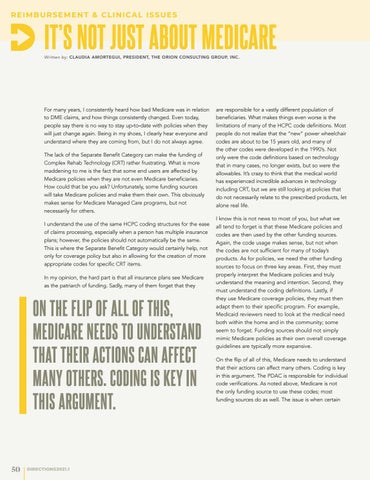RE I M B U R SEME NT & C L IN ICAL ISSUES
IT’S NOT JUST ABOUT MEDICARE Written by: CLAUDIA AMORTEGUI, PRESIDENT, THE ORION CONSULTING GROUP, INC.
For many years, I consistently heard how bad Medicare was in relation to DME claims, and how things consistently changed. Even today, people say there is no way to stay up-to-date with policies when they will just change again. Being in my shoes, I clearly hear everyone and understand where they are coming from, but I do not always agree. The lack of the Separate Benefit Category can make the funding of Complex Rehab Technology (CRT) rather frustrating. What is more maddening to me is the fact that some end users are affected by Medicare policies when they are not even Medicare beneficiaries. How could that be you ask? Unfortunately, some funding sources will take Medicare policies and make them their own. This obviously makes sense for Medicare Managed Care programs, but not necessarily for others. I understand the use of the same HCPC coding structures for the ease of claims processing, especially when a person has multiple insurance plans; however, the policies should not automatically be the same. This is where the Separate Benefit Category would certainly help, not only for coverage policy but also in allowing for the creation of more appropriate codes for specific CRT items. In my opinion, the hard part is that all insurance plans see Medicare as the patriarch of funding. Sadly, many of them forget that they
ON THE FLIP OF ALL OF THIS, MEDICARE NEEDS TO UNDERSTAND THAT THEIR ACTIONS CAN AFFECT MANY OTHERS. CODING IS KEY IN THIS ARGUMENT.
50
DIRECTIONS 2021.1
are responsible for a vastly different population of beneficiaries. What makes things even worse is the limitations of many of the HCPC code definitions. Most people do not realize that the “new” power wheelchair codes are about to be 15 years old, and many of the other codes were developed in the 1990’s. Not only were the code definitions based on technology that in many cases, no longer exists, but so were the allowables. It’s crazy to think that the medical world has experienced incredible advances in technology including CRT, but we are still looking at policies that do not necessarily relate to the prescribed products, let alone real life. I know this is not news to most of you, but what we all tend to forget is that these Medicare policies and codes are then used by the other funding sources. Again, the code usage makes sense, but not when the codes are not sufficient for many of today’s products. As for policies, we need the other funding sources to focus on three key areas. First, they must properly interpret the Medicare policies and truly understand the meaning and intention. Second, they must understand the coding definitions. Lastly, if they use Medicare coverage policies, they must then adapt them to their specific program. For example, Medicaid reviewers need to look at the medical need both within the home and in the community; some seem to forget. Funding sources should not simply mimic Medicare policies as their own overall coverage guidelines are typically more expansive. On the flip of all of this, Medicare needs to understand that their actions can affect many others. Coding is key in this argument. The PDAC is responsible for individual code verifications. As noted above, Medicare is not the only funding source to use these codes; most funding sources do as well. The issue is when certain









